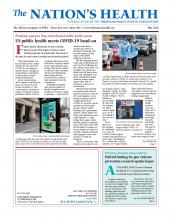Finding common ground and building trust between local stakeholders could help prevent violent encounters between police and young black men, new research finds.
In the U.S., young black men face a disproportionately high risk of being injured or killed in violent encounters with law enforcement, with police killings a leading cause of death among black men. To help determine underlying factors that contribute to the inequity as well as areas of possible intervention, public health researchers at the University of Minnesota School of Public Health surveyed nearly 50 people across stakeholder groups on the relationship between police and young black men.
A key takeaway was that many believed that a lack of connection between police and the communities they served was a major contributor to violent encounters.
“We heard a lot of talk about distrust and fear,” lead author Collin Calvert, MPH, a PhD student at the school, told The Nation’s Health. “And when people talked about positive interactions (with police), it was consistently about officers that they knew well.”
To conduct the study, published in January in the Journal of Urban Health, Calvert and co-authors surveyed 48 stakeholders in Minneapolis and St. Paul, including young black men ages 14 to 24, parents, educators, police officers and staff working at organizations that served youth.
Participants were asked to identify causes of violent encounters between police and young black men, describe police officers who serve in their communities and describe interactions between police and young black men. Calvert noted that while previous qualitative studies on police violence have captured the perspectives of youth and police, few have collected input from other stakeholder groups such as teachers and youth service providers.
The study found that with the exception of police, all stakeholder groups felt that violent encounters between police and young black men were caused by the officers’ lack of connection with the community. Youth respondents feared police after having seen or heard about violent encounters, while officers said they feared youth due to the availability of guns and previous assaults on police. Many stakeholders said that racism among police and the over-policing of black neighborhoods contributed to violent encounters.
For example, one parent said that some police were rude and did not “see” them.
“They see me, but they really don’t see who (I am) because...to them, I’m nobody,” said the parent, who was quoted in the study.
Positive experiences with police were usually described in the context of police-hosted community events and interactions that occurred during times of less aggressive policing. Such encounters were often associated with officers who had developed relationships with residents and who focused on de-escalation during policing encounters.
“We have cops that have worked the north side for years, and people know who they are, and they respect these officers,” one officer told researchers. “They know how to work with people and calm the situation down.”
Overall, Calvert said, the study highlighted the importance of building trust and identifying areas of consensus when developing programs to successfully close the police violence disparity.
“For any prevention effort out there working on this issue, I hope this study shows why it’s important to involve lots of different stakeholder groups and not just keep it in-house,” he said. “Getting that community input is so important for designing something that’s effective and that people actually want to engage with.”
For more information, read the study online.
- Copyright The Nation’s Health, American Public Health Association









